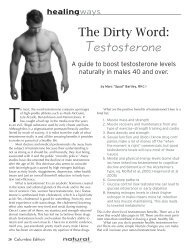February 2013: Bodywork and Relationships - Columbia Natural ...
February 2013: Bodywork and Relationships - Columbia Natural ...
February 2013: Bodywork and Relationships - Columbia Natural ...
Create successful ePaper yourself
Turn your PDF publications into a flip-book with our unique Google optimized e-Paper software.
<strong>Bodywork</strong> Goes<br />
MAINSTREAM<br />
Helpful Access Points to Health<br />
by Linda Sechrist<br />
The seed holds within itself hints of its magnificent maturity. So it is<br />
with the practice of whole-person health care, which has matured<br />
in language, sophistication, credibility <strong>and</strong> acceptance. In a single<br />
generation, we’ve seen its presence grow from the outer edges of<br />
wholistic <strong>and</strong> alternative wellness to complementary <strong>and</strong> integrative<br />
health care. Its latest evolution into America’s mainstream is known as<br />
functional medicine. The branch of massage therapy, the germination<br />
point for myriad therapies collectively known as bodywork, patterns<br />
the movement’s development.<br />
Once considered a luxury for<br />
the pampered few, massage<br />
was among the first therapies<br />
to be widely recognized by physicians<br />
as a respected aspect of integrative<br />
<strong>and</strong> functional medicine. <strong>Bodywork</strong><br />
increasingly shares this status, as it is<br />
included in conventional medicine’s<br />
more innovative health care models<br />
that embrace a body, mind <strong>and</strong> spirit<br />
approach. One of many examples is<br />
Duke Integrative Medicine, in Durham,<br />
NC, where patient services include a<br />
form of integrative massage that blends<br />
Swedish massage, myofascial therapy,<br />
reflexology, energy work <strong>and</strong> somatic<br />
therapy techniques.<br />
In the public’s view, bodywork is<br />
still largely associated with massage,<br />
although distinct forms st<strong>and</strong> on their<br />
own, including Rolfing, structural<br />
integration, shiatsu <strong>and</strong> myofascial<br />
<strong>and</strong> craniosacral therapies. <strong>Bodywork</strong><br />
professionals generally belong to the<br />
American Massage Therapy Association<br />
(AMTA), whatever their specialized<br />
modality. They may also participate in<br />
other professional organizations, such<br />
as the Associated <strong>Bodywork</strong> & Massage<br />
Professionals, which has some 80,000<br />
members, many of which are also<br />
members of the International Association<br />
for Structural Integrators. These<br />
nonprofits’ websites help individuals<br />
locate practitioners in their area.<br />
According to Maureen Moon, past<br />
president of AMTA, many massage<br />
therapists (which don’t refer to themselves<br />
as bodyworkers) are trained in<br />
various bodywork therapies <strong>and</strong> intuitively<br />
integrate them into their sessions,<br />
depending upon each client’s needs.<br />
She notes that “many AMTA<br />
members are so passionate about their<br />
profession <strong>and</strong> meeting the continuing<br />
education (CEU) requirements that<br />
they go far beyond the units required<br />
to maintain their license, which can<br />
vary from state-to-state.” For example,<br />
Moon has trained in spinal reflex<br />
analysis, developed by Dr. Frank Jarrell,<br />
neuromuscular <strong>and</strong> craniosacral<br />
therapies, shiatsu <strong>and</strong> seven massage<br />
therapies. “Most AMTA members<br />
are CEU junkies,” quips Moon, who<br />
points out that national conventions<br />
provide continuing education <strong>and</strong><br />
chapter meetings frequently introduce<br />
attendees to new techniques.<br />
Some practitioners discover specialties<br />
while in search of pain relief for<br />
personal injuries or other conditions.<br />
Myofascial Therapy<br />
Olympia Hostler, a myofascial therapist<br />
in Tinton Falls, NJ, had two serious<br />
horse riding accidents during adolescence<br />
<strong>and</strong> three automobile accidents<br />
by age 40, which combined, left her<br />
so incapacitated that she could barely<br />
walk. “I couldn’t work for three years,<br />
because I was so debilitated,” relates<br />
Hostler. She found her doctor’s diagnosis<br />
of severe permanent damage to the<br />
body’s soft connective tissue, or fascia,<br />
<strong>and</strong> the prognosis of a lifetime of living<br />
with pain unacceptable. So she began<br />
searching for something that would<br />
help restore health. Her investigation<br />
of therapies ended with myofascial<br />
release, an effective whole-body ap-<br />
HealthyLiving<strong>Columbia</strong>.com<br />
<strong>February</strong> <strong>2013</strong><br />
15







